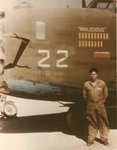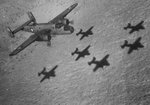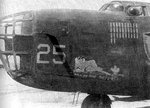I know I wrote this in the Tactical Airstrikes thread, but because it helps me remember and teaches others about the war ... I thought I'd start my own thread on it. Sorry for the duplication. It's also, as always, up for discussion or any questions... since most of the USAAF light shines directly on to the U.S Eighth Air Force.
History of the U.S Ninth Air Force
The story of the U.S Ninth began when twenty-three B-24D Liberators landed in the Middle-East. These planes belonged to Halverson Detachment (CO Col. Harry A. Halverson) which was on it's way to China with the plan to attack Japan from airfields there.
The planes were held-up in the Middle-East by an order to attack the Ploesti oil refineries in Romania, the largest supplier of oil to the Axis war machine. On 11 June thirteen Liberators took off from Fayid, Egypt arriving individually over target at dawn on the 12th. Ten bombers the Astra Romana Refinery at Ploesti, one attacked the port at Constanta and two dropped bombs on other unidentified targets. This was the first mission of planes that would become part of the US Ninth Air Force later in the year.
HALPRO (Codename for Halverson Detachment) was then ordered to stay in the Middle-East as the only force capable of striking the Afrika Korps supply line at it's head. They attacked the supply ships in open sea, and in the ports of Tobruk and Benghazi throughout June.
On 28 June, they attacked motor transport and tanks on the Sollum-Matrah Road. The emergency of the situation was so great, these heavy bombers were at times thrown into the tactical role. On the same day seven B-17E bombers arrived at Fayid, these were from the 9th Bomb Squadron, 7th Bomb Group. The squadron had arrived from the India where it had been fighting the Japanese. The commanding officer, Major-General Lewis H. Brereton, was placed in command of the United States Army Middle-East Air Force (USAMEAF).
Both the B-17s and B-24s joined up starting in July to continue their attacks on the Axis shipping. On the 5th, five more B-17Es arrived from 9th Bomb Squadron and 436th Bomb Squadron. On 20 July, 1942, the heavy bomber forces in the Middle-East were formed into the First Provisional Group based at Lydda, Palestine. This consisted of the Halverson (B-24Ds) and Brereton (B-17Es) squadrons. This group and RAF 160 Squadron (with Liberators) were the only heavy bombers in the theatre.
During July three new groups began moving toward the Middle-East, these were 98th Bomb Group (Heavy), 57th Fighter Group and 12th Bomb Group (Medium) equipped with B-24D, P-40F and B-25C respectively. The first mission by any of these groups was on 1 August, 1942 when seven B-24s from 344th Bomb Squadron (98th BG) attacked Mersa Matruh.
The 98th BG had fully deployed by 20 August, and had brought 34 B-24s to the theatre (35 were sent, but one was lost on route with it's crew).
57th FG arrived in full on 17 August, but had started operations before then. It had brought 72 P-40F Warhawks to the Mid-East, which were mostly brought across aboard USS Ranger.
The 12th BG arrived last, fully forming on 18 August but flew it's first mission on the 16th. This group brought 57 B-25C Mitchells to the Mid-East.
Picture: Malicious. A B-24D originally of "C" Flight, HALPRO. Pilot was Capt. Richard C. Sanders.
History of the U.S Ninth Air Force
The story of the U.S Ninth began when twenty-three B-24D Liberators landed in the Middle-East. These planes belonged to Halverson Detachment (CO Col. Harry A. Halverson) which was on it's way to China with the plan to attack Japan from airfields there.
The planes were held-up in the Middle-East by an order to attack the Ploesti oil refineries in Romania, the largest supplier of oil to the Axis war machine. On 11 June thirteen Liberators took off from Fayid, Egypt arriving individually over target at dawn on the 12th. Ten bombers the Astra Romana Refinery at Ploesti, one attacked the port at Constanta and two dropped bombs on other unidentified targets. This was the first mission of planes that would become part of the US Ninth Air Force later in the year.
HALPRO (Codename for Halverson Detachment) was then ordered to stay in the Middle-East as the only force capable of striking the Afrika Korps supply line at it's head. They attacked the supply ships in open sea, and in the ports of Tobruk and Benghazi throughout June.
On 28 June, they attacked motor transport and tanks on the Sollum-Matrah Road. The emergency of the situation was so great, these heavy bombers were at times thrown into the tactical role. On the same day seven B-17E bombers arrived at Fayid, these were from the 9th Bomb Squadron, 7th Bomb Group. The squadron had arrived from the India where it had been fighting the Japanese. The commanding officer, Major-General Lewis H. Brereton, was placed in command of the United States Army Middle-East Air Force (USAMEAF).
Both the B-17s and B-24s joined up starting in July to continue their attacks on the Axis shipping. On the 5th, five more B-17Es arrived from 9th Bomb Squadron and 436th Bomb Squadron. On 20 July, 1942, the heavy bomber forces in the Middle-East were formed into the First Provisional Group based at Lydda, Palestine. This consisted of the Halverson (B-24Ds) and Brereton (B-17Es) squadrons. This group and RAF 160 Squadron (with Liberators) were the only heavy bombers in the theatre.
During July three new groups began moving toward the Middle-East, these were 98th Bomb Group (Heavy), 57th Fighter Group and 12th Bomb Group (Medium) equipped with B-24D, P-40F and B-25C respectively. The first mission by any of these groups was on 1 August, 1942 when seven B-24s from 344th Bomb Squadron (98th BG) attacked Mersa Matruh.
The 98th BG had fully deployed by 20 August, and had brought 34 B-24s to the theatre (35 were sent, but one was lost on route with it's crew).
57th FG arrived in full on 17 August, but had started operations before then. It had brought 72 P-40F Warhawks to the Mid-East, which were mostly brought across aboard USS Ranger.
The 12th BG arrived last, fully forming on 18 August but flew it's first mission on the 16th. This group brought 57 B-25C Mitchells to the Mid-East.
Picture: Malicious. A B-24D originally of "C" Flight, HALPRO. Pilot was Capt. Richard C. Sanders.





